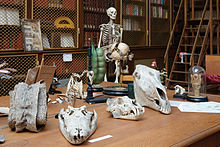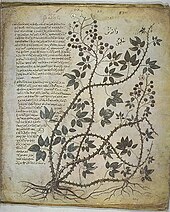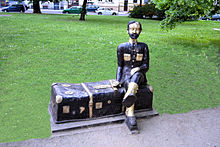Natural history
Natural history is a domain of inquiry involving organisms, including animals, fungi, and plants, in their natural environment, leaning more towards observational than experimental methods of study. A person who studies natural history is called a naturalist or natural historian.
Natural history encompasses
Definitions
Before 1900
The meaning of the English term "natural history" (a calque of the Latin historia naturalis) has narrowed progressively with time, while, by contrast, the meaning of the related term "nature" has widened (see also History below).
In antiquity, "natural history" covered essentially anything connected with nature, or used materials drawn from nature, such as Pliny the Elder's encyclopedia of this title, published c. 77 to 79 AD, which covers astronomy, geography, humans and their technology, medicine, and superstition, as well as animals and plants.
Natural history had been encouraged by practical motives, such as Linnaeus' aspiration to improve the economic condition of Sweden.[3] Similarly, the Industrial Revolution prompted the development of geology to help find useful mineral deposits.[4]
Since 1900

Modern definitions of natural history come from a variety of fields and sources, and many of the modern definitions emphasize a particular aspect of the field, creating a plurality of definitions with a number of common themes among them. For example, while natural history is most often defined as a type of observation and a subject of study, it can also be defined as a body of knowledge, and as a craft or a practice, in which the emphasis is placed more on the observer than on the observed.[5]
Definitions from biologists often focus on the scientific study of individual organisms in their environment, as seen in this definition by Marston Bates: "Natural history is the study of animals and Plants—of organisms. ... I like to think, then, of natural history as the study of life at the level of the individual—of what plants and animals do, how they react to each other and their environment, how they are organized into larger groupings like populations and communities"[6] and this more recent definition by D.S. Wilcove and T. Eisner: "The close observation of organisms—their origins, their evolution, their behavior, and their relationships with other species".[7]
This focus on organisms in their environment is also echoed by H.W. Greene and J.B. Losos: "Natural history focuses on where organisms are and what they do in their environment, including interactions with other organisms. It encompasses changes in internal states insofar as they pertain to what organisms do".[8]
Some definitions go further, focusing on direct observation of organisms in their environments, both past and present, such as this one by G.A. Bartholomew: "A student of natural history, or a naturalist, studies the world by observing plants and animals directly. Because organisms are functionally inseparable from the environment in which they live and because their structure and function cannot be adequately interpreted without knowing some of their evolutionary history, the study of natural history embraces the study of fossils as well as physiographic and other aspects of the physical environment".[9]
A common thread in many definitions of natural history is the inclusion of a descriptive component, as seen in a recent definition by H.W. Greene: "Descriptive ecology and ethology".[10] Several authors have argued for a more expansive view of natural history, including S. Herman, who defines the field as "the scientific study of plants and animals in their natural environments. It is concerned with levels of organization from the individual organism to the ecosystem, and stresses identification, life history, distribution, abundance, and inter-relationships.
It often and appropriately includes an esthetic component",[11] and T. Fleischner, who defines the field even more broadly, as "A practice of intentional, focused attentiveness and receptivity to the more-than-human world, guided by honesty and accuracy".[12] These definitions explicitly include the arts in the field of natural history, and are aligned with the broad definition outlined by B. Lopez, who defines the field as the "Patient interrogation of a landscape" while referring to the natural history knowledge of the Eskimo (Inuit).[13]
A slightly different framework for natural history, covering a similar range of themes, is also implied in the scope of work encompassed by many leading natural history museums, which often include elements of anthropology, geology, paleontology, and astronomy along with botany and zoology,[14][15] or include both cultural and natural components of the world.[16]
The plurality of definitions for this field has been recognized as both a weakness and a strength, and a range of definitions has recently been offered by practitioners in a recent collection of views on natural history.[17]
History
Ancient

Natural history begins with Aristotle and other ancient philosophers who analyzed the diversity of the natural world. Natural history was understood by Pliny the Elder to cover anything that could be found in the world, including living things, geology, astronomy, technology, art, and humanity.[18]
From the
Medieval
Natural history was basically static through the
The British historian of Chinese science
Modern
A significant contribution to English natural history was made by parson-naturalists such as Gilbert White, William Kirby, John George Wood, and John Ray, who wrote about plants, animals, and other aspects of nature. Many of these men wrote about nature to make the natural theology argument for the existence or goodness of God.[22] Since early modern times, however, a great number of women made contributions to natural history, particularly in the field of botany, be it as authors, collectors, or illustrators.[23]
In modern Europe, professional disciplines such as botany, geology,
Amateur collectors and natural history entrepreneurs played an important role in building the world's large natural history collections, such as the Natural History Museum, London, and the National Museum of Natural History in Washington, DC.
Three of the greatest English naturalists of the 19th century, Henry Walter Bates, Charles Darwin, and Alfred Russel Wallace—who knew each other—each made natural history travels that took years, collected thousands of specimens, many of them new to science, and by their writings both advanced knowledge of "remote" parts of the world—the Amazon basin, the Galápagos Islands, and the Indonesian Archipelago, among others—and in so doing helped to transform biology from a descriptive to a theory-based science.
The understanding of "Nature" as "an organism and not as a mechanism" can be traced to the writings of Alexander von Humboldt (Prussia, 1769–1859). Humboldt's copious writings and research were seminal influences for Charles Darwin, Simón Bolívar, Henry David Thoreau, Ernst Haeckel, and John Muir.[25]
Museums
Natural history museums, which evolved from cabinets of curiosities, played an important role in the emergence of professional biological disciplines and research programs. Particularly in the 19th century, scientists began to use their natural history collections as teaching tools for advanced students and the basis for their own morphological research.
Societies

The term "natural history" alone, or sometimes together with archaeology, forms the name of many national, regional, and local natural history societies that maintain records for
Examples of these societies in Britain include the
Societies in other countries include the American Society of Naturalists and Polish Copernicus Society of Naturalists.
Professional societies have recognized the importance of natural history and have initiated new sections in their journals specifically for natural history observations to support the discipline. These include "Natural History Field Notes" of
See also
- Evolutionary history of life
- History of evolutionary thought
- Naturalism (philosophy)
- Nature documentary
- Nature study
- Nature writing
- Russian naturalists
- Timeline of natural history
- Natural science
References
- ^ With "natural history" articles more often published today in science magazines than in academic journals.Natural History WordNet Search, princeton.edu Archived 2012-03-03 at the Wayback Machine.
- ISBN 0-19-861271-0
- ISBN 978-0-674-09745-2.
- ^ Barry Barnes and Steven Shapin, "Natural order: historical studies of scientific culture", Sage, 1979.
- ISBN 978-1-59534-074-0.
- ^ Marston Bates, The nature of natural history, Scribners, 1954.
- ^ D. S Wilcove and T. Eisner, "The impending extinction of natural history," Chronicle of Higher Education 15 (2000): B24
- JSTOR 1310949.
- JSTOR 1310237.
- PMID 16701336.
- JSTOR 3802927.
- ^ T. L. Fleischner, "Natural history and the spiral of offering", Wild Earth 11, no. 3/4 (2002): 10–13
- ^ Barry Lopez, Arctic Dreams, Vintage, 1986.
- ^ American Museum of Natural History, Mission Statement Archived 2011-06-04 at the Wayback Machine
- ^ Field Museum, Mission Statement Archived 2012-01-03 at the Wayback Machine
- ^ The Natural History Museum, Mission Statement Archived 2014-12-27 at the Wayback Machine
- ^ An Accepted Way of Viewing Art
- ISBN 978-0-14-044413-1.
- ISBN 0-674-36153-9
- ^ a b "Natural History Timeline Archived 2010-12-31 at the Wayback Machine". HistoryofScience.com.
- ^ Needham, J., & Ling, W. (1976). Science and civilization in China (Vol. 5, part.3, p. 216). Cambridge: Cambridge University Press
- ISBN 978-0-85244-516-7. Retrieved 31 March 2013.
- ^ "Women in Botany". Archived from the original on 2019-09-03. Retrieved 2019-12-19.
- PMID 18761284
- ^ Andrea Wulf (2015),The Invention of Nature, Knopf [page needed]
- ^ "Whitby Naturalists' Club". whitbynaturalists.co.uk. Archived from the original on January 24, 2018. Retrieved January 23, 2018.
- ^ Mabbett, Andy (20 November 2010). "Older Organisations". West Midland Bird Club. Archived from the original on 23 May 2013. Retrieved 11 February 2015.
{{cite web}}: CS1 maint: unfit URL (link) - ISSN 0006-3606.
- ISSN 1524-4695.
Further reading
- Allen, David Elliston (1994), The Naturalist in Britain: a social history, New Jersey: Princeton University Press, p. 270, ISBN 0-691-03632-2
- Liu, Huajie (2012), Living as a Naturalist, Beijing: Peking University Press, p. 363, ISBN 978-7-301-19788-2
- Peter Anstey (2011), Two Forms of Natural History Archived 2011-08-09 at the Wayback Machine, Early Modern Experimental Philosophy Archived 2011-07-21 at the Wayback Machine.
- Atran, Scott (1990), Cognitive Foundations of Natural History: Towards an Anthropology of Science, Cambridge, UK: Cambridge University Press, p. 376, ISBN 978-0-521-43871-1
- Farber, Paul Lawrence (2000), Finding Order in Nature: The Naturalist Tradition from Linnaeus to E. O. Wilson. Johns Hopkins University Press: Baltimore.
- Kohler, Robert E. (2002), Landscapes and Labscapes: Exploring the Lab-Field Border in Biology. University of Chicago Press: Chicago.
- Mayr, Ernst. (1982), The Growth of Biological Thought: Diversity, Evolution, and Inheritance. The Belknap Press of Harvard University Press: Cambridge, Massachusetts.
- Rainger, Ronald; Keith R. Benson; and Jane Maienschein (eds) (1988), The American Development of Biology. University of Pennsylvania Press: Philadelphia.
External links
- A History of the Ecological Sciences by Frank N. Egerton


